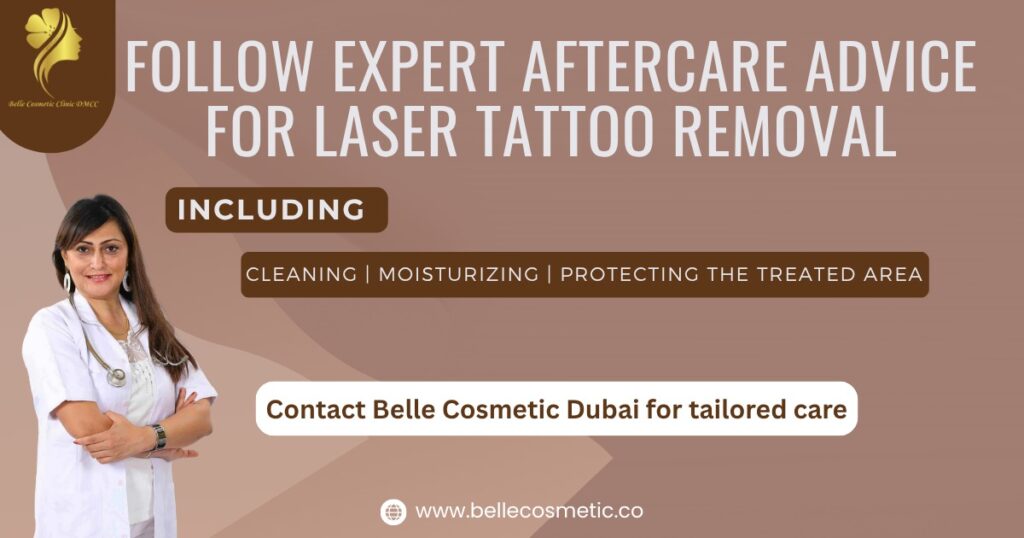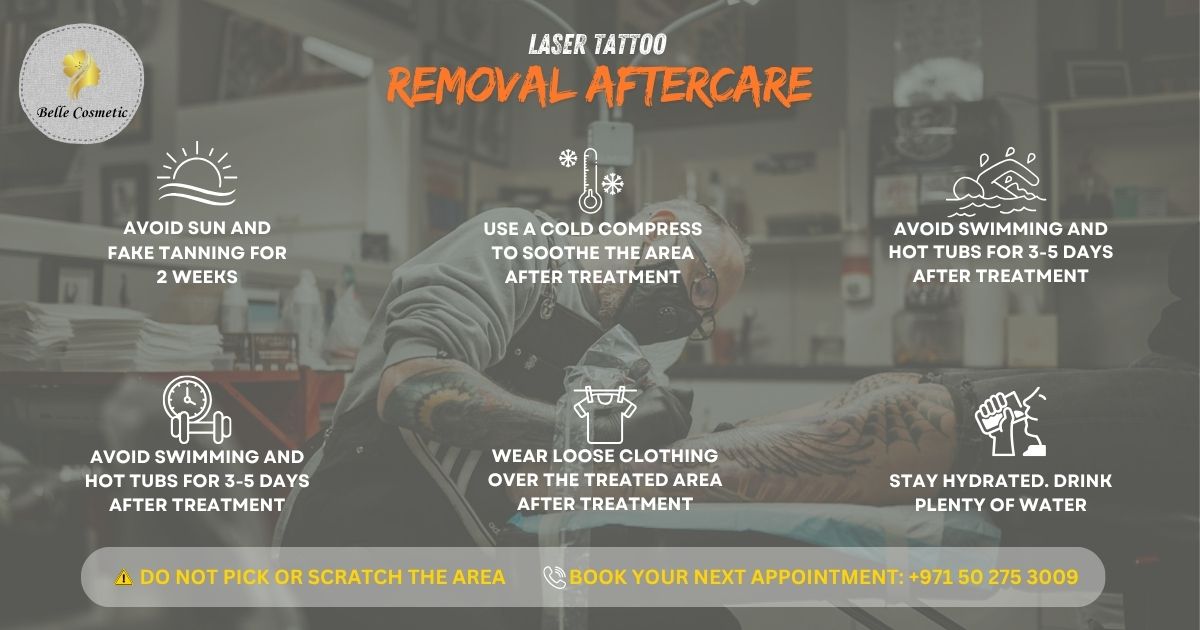While laser tattoo removal is a very effective and safe way to remove unwanted tattoos, the post-session care is very crucial for a smooth healing process. It is important because the laser beams create a slight injury to the treatment spots where the ink particles were broken down. Laser tattoo removal triggers the skin tissues mildly, and hence, the body’s immune system starts acting on it by trying to flush out the broken ink particles. During this process, the skin might be subjected to irritation, redness, and infection. With proper aftercare, you can prevent complications and ensure healing for scar-free skin. At Belle Cosmetic in Dubai, we offer a personalised aftercare plan combined with expert guidance for you to make sure your skin heals safely. Learn more about why clients choose us as the best in our industry.
The tattoo removal procedures will have a break between each session for 4–8 weeks, after which the next session takes place. Immediately after the treatment session, the area would appear tender, and redness would be there, which is a normal reaction of the skin to the laser beams. At Belle Cosmetic in Dubai, the tattoo removal immediate care is usually done as follows.
First week care: The treated area will be covered with a sterile bandage applied by your specialist, which should be removed only after 2–3 hours. After that, you can apply a cold compress to reduce swelling or discomfort. However, you must not apply it directly to the skin because, it may cause frostbite. Instead, it must be wrapped in a clean cloth. Give a break of 20 minutes between each application. Precautions must be taken to avoid sun exposure or heat.
The treated area must be cleaned with gentle soap recommended by the specialist and lukewarm water. This helps to remove any residual inks or fluids. Remember not to rub the skin while washing. You must avoid showering for at least one day. Because if you do all this, it can cause skin irritation. Cleaning this way at the suggested timings will prevent bacterial buildup by promoting a germ-free environment to accelerate the healing. Moisturizing care should be given by applying medically approved ointments like Vaseline or Aquaphor to relieve any irritation, which helps to moisturize and give a soothing effect.
Laser tattoo removal healing is a slow process, which normally takes place fully in about 8 months, as the healing might take its own time. You must be committed to the proper care of the treated area for a long time. With a climate including heat, humidity, and high UV exposure, the tattoo removal healing process in Dubai has to be taken seriously to ensure you are free from any complications. Keeping consistent in taking care ensures permanent and effective healing. In the first few weeks, the skin will start shedding its damaged parts.
During the following months, your body tries to restore the treated parts by clearing the ink particles using its immune system continuously. You must stay well hydrated and maintain a healthy diet during this stage. Long-term care also recommends that if you have a habit of smoking, then you must stop it, as it will disturb the healing process.
As a part of your body’s healing response to laser tattoo removal, you may notice scabs or blisters. These are considered a normal reaction of the skin to the laser beams shot into the skin. This happens because the laser generates heat in the surrounding tissues, and it temporarily irritates the outermost layer of tissues slightly, forming blisters or scabs. It usually happens within the first 24 hours after the treatment is done. You are told not to pick up scabs or rub on any blisters, as it might trigger an infection in the surrounding areas of treatment. If you notice any redness or warmth with pus, or pain, then you must consult your specialist immediately. All the precautions taken properly will avoid the skin from getting infected.

Dubai City’s heat and humidity make it compulsory to follow the aftercare process seriously to avoid infections.
You have to come and visit our specialist if you notice any of the following issues.
If you have any unusual signs other than the common ones mentioned above. Don’t keep your doubts with you; instead, visit the medical specialist immediately.
Do you have any concerns or questions now? At Belle Cosmetic Dubai, we have solutions for every concern that you might have, with a separate tattoo removal consultation where you can connect with the certified specialist who will guide you further. So what are you waiting for? Do not hesitate;connect with us today.
Once you attend a tattoo removal session, the healing process begins. Healing is not a one-day process. The tattoo inks fade out very slowly after a certain number of sessions, but typically, the healing is supposed to take place naturally with proper aftercare done as recommended by your specialist. There is a gap of 6-8 weeks in between sessions to give it time to repair naturally.
When the laser beams hit the tattooed ink, they break it down into tiny ink particles. Then it gets flushed away by the body naturally. It is done by the body’s immune system. So once you sit for multiple sessions, the ink will fade away slowly but completely. It’s your body that plays a major role in erasing the ink.
With modern laser tattoo removal technologies like Q-switched and PicoWay, there won’t be any scars left behind on your skin. But you need to be committed to proper aftercare steps to help yourself get scar-free skin.
Immediately after the tattoo removal session, a cold compress is given to soothe any swelling or irritation in the skin. A bandage will be applied. During the following weeks and months, the aftercare process will continue and include more steps for aftercare. These are avoiding sun exposure, tanning, swimming, high-intensity workouts, tight clothing, etc. Approved antibiotic/moisturising and sunscreen ointments may be applied to prevent infection and sunburn. You must stay hydrated and maintain a healthy diet during the healing process.
Usually, you are asked not to shower after the treatment, but if it’s necessary, then you can take a shower gently with lukewarm water and no pressure in the water flow. Avoid scrubbing or exfoliating the skin while showering. This can be done only after 4 hours of tattoo removal.
No, you are not recommended to be in the sun after tattoo removal, as the harsh UV rays from the sun will cause sunburns, and you will get injured very badly. Even if it’s indirect sunlight, you must be moisturised and apply an SPF 30+ sunscreen on the treated area. But never should you be exposed to direct sunlight.

Follow us on :
Belle Cosmetic Clinic © 2025All Rights Reserved. Designed by 1WebWorld